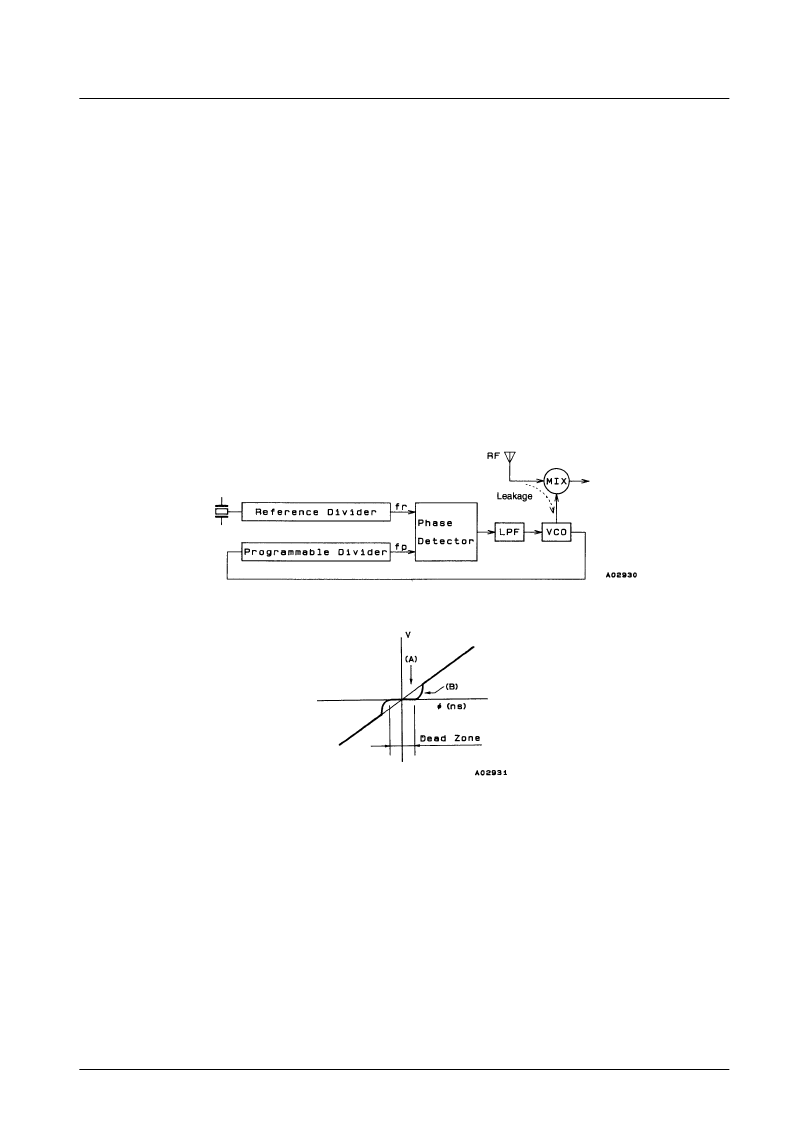- 您現(xiàn)在的位置:買賣IC網 > PDF目錄358759 > LC72136N (Sanyo Electric Co.,Ltd.) PLL Frequency Synthesizer for Electronic Tuning(用于電子調諧的鎖相環(huán)頻率合成器) PDF資料下載
參數(shù)資料
| 型號: | LC72136N |
| 廠商: | Sanyo Electric Co.,Ltd. |
| 英文描述: | PLL Frequency Synthesizer for Electronic Tuning(用于電子調諧的鎖相環(huán)頻率合成器) |
| 中文描述: | 鎖相環(huán)頻率合成器電子調諧(用于電子調諧的鎖相環(huán)頻率合成器) |
| 文件頁數(shù): | 21/23頁 |
| 文件大?。?/td> | 319K |
| 代理商: | LC72136N |

No. 5608-21/23
LC72136N, 72136NM
Schemes in which a dead zone is present (OFF/OFF) have good loop stability, but have the problem that acquiring a
high C/N ratio can be difficult. On the other hand, although it is easy to acquire a high C/N ratio with schemes in
which there is no dead zone, it is difficult to achieve high loop stability. Therefore, it can be effective to select DZA
or DZB, which have no dead zone, in applications which require an FM S/R ratio in excess of 90 to 100 dB, or in
which an increased AM stereo pilot margin is desired. On the other hand, we recommend selecting DZC or DZD,
which provide a dead zone, for applications which do not require such a high FM signal-to-noise ratio and in which
either AM stereo is not used or an adequate AM stereo pilot margin can be achieved.
Dead Zone
The phase comparator compares fp to a reference frequency (fr) as shown in Figure 4. Although the characteristics of
this circuit (see Figure 5) are such that the output voltage is proportional to the phase difference (line A), a region
(the dead zone) in which it is not possible to compare small phase differences occurs in actual ICs due to internal
circuit delays and other factors (line B). A dead zone as small as possible is desirable for products that must provide
a high S/N ratio.
However, since a larger dead zone makes this circuit easier to use, a larger dead zone is appropriate for popularly-
priced products. This is because it is possible for RF signals to leak from the mixer to the VCO and modulate the
VCO in popularly-priced products in the presence of strong RF inputs. When the dead zone is narrow, the circuit
outputs correction pulses and this output can further modulate the VCO and generate beat frequencies with the RF
signal.
Figure 4
Figure 5
2. Notes on the FMIN, AMIN, and IFIN Pins
Coupling capacitors must be placed as close as possible to their respective pin. A capacitance of about 100 pF is
desirable. In particular, if a capacitance of 1000 pF or over is used for the IF pin, the time to reach the bias level will
increase and incorrect counting may occur due to the relationship with the wait time.
3. Notes on IF Counting
→
SD must be used in conjunction with the IF counting time
When using IF counting, always implement IF counting by having the microprocessor determine the presence of the
IF-IC SD (station detect) signal and turn on the IF counter buffer only if the SD signal is present. Schemes in which
auto-searches are performed with only IF counting are not recommended, since they can stop at points where there is
no signal due to leakage output from the IF counter buffer.
相關PDF資料 |
PDF描述 |
|---|---|
| LC72136 | PLL Frequency Synthesizer for Electronic Tuning(用于電子調諧的鎖相環(huán)頻率合成器) |
| LC72137 | PLL Frequency Synthesizer for Electronic Tuning(用于電子調諧的鎖相環(huán)頻率合成器) |
| LC72140 | PLL Frequency Synthesizer(鎖相環(huán)頻率合成器) |
| LC72144M | PLL Frequency Synthesizer(鎖相環(huán)頻率合成器) |
| LC72146 | PLL Frequency Synthesizer for Electronic Tuning(用于電子調諧的鎖相環(huán)頻率合成器) |
相關代理商/技術參數(shù) |
參數(shù)描述 |
|---|---|
| LC72136N-D-E | 制造商:ON Semiconductor 功能描述:PLL FREQUENCY SYNTHESIZER - Ammo Pack |
| LC72136NM | 制造商:SANYO 制造商全稱:Sanyo Semicon Device 功能描述:PLL Frequency Synthesizer for Electronic Tuning |
| LC72137 | 制造商:SANYO 制造商全稱:Sanyo Semicon Device 功能描述:PLL Frequency Synthesizer |
| LC72137_11 | 制造商:SANYO 制造商全稱:Sanyo Semicon Device 功能描述:PLL Frequency Synthesizer |
| LC72137M | 制造商:SANYO 制造商全稱:Sanyo Semicon Device 功能描述:PLL Frequency Synthesizer for Electronic Tuning |
發(fā)布緊急采購,3分鐘左右您將得到回復。